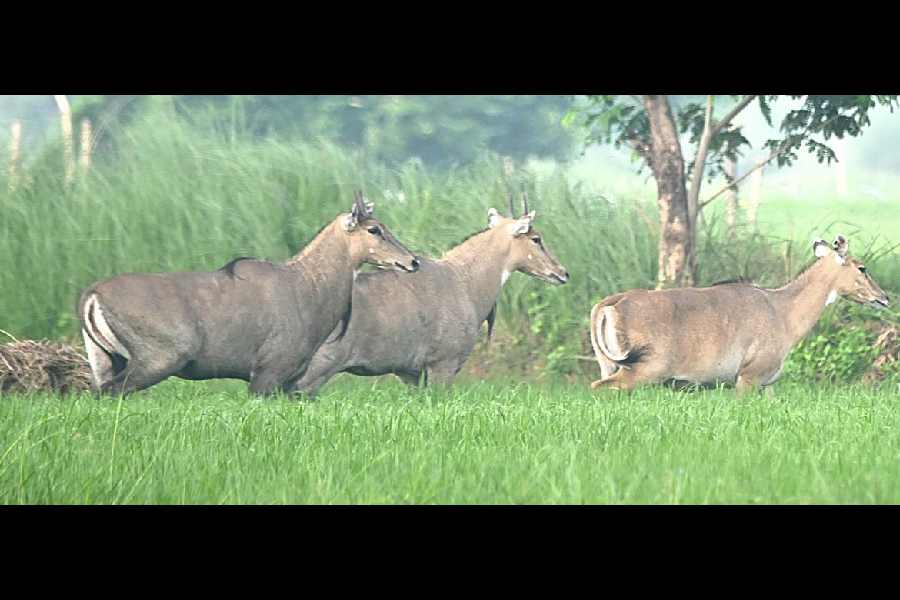Night after night over the past week, Chhavikant Singh, a farmer in Bihar’s Rohtas district, has patrolled his patches of paddy and vegetable farmland, hoping to keep out herds of nilgai, the largest among Asian antelopes, from feeding on his crops.
After multiple sleepless nights and days that are largely spent on farm-related and other engagements, Singh is overwhelmed, knowing he’ll need to sleep soon. Across Bihar’s villages, the nilgai has come to be known as an animal with the appetite of a cow, the alertness of a dog and the speed of a horse.
“I haven’t slept properly for even an hour over the past several days — my head is spinning,” Singh, 58, said on Friday as he walked around in a disoriented manner, his eyes scanning the horizon looking out for nilgai. “I roam through the night from one patch of land to another to protect my crops.”
Some believe the antelope’s name — nilgai, meaning “blue cow” — has also contributed to the farmers’ woes, for in a land where the cow is revered, many would hesitate to harm the nilgai. “We can’t harm or kill them — paap lagega (it will be a sin),” Singh said.
Singh’s plight is shared by farmers across large tracts of Bihar where the menace posed by nilgais has touched unprecedented levels. State government officials estimate that the nilgai population in the state is now over 300,000.
An adult nilgai typically weighs anywhere from 150kg to 300kg and reaches a height of five feet at their shoulders. Farmers describe nilgais as shy animals but capable of ravaging crops at unbelievable speeds.
Farmers who have spent decades observing nilgai say the animals previously used to graze during the daytime but appear to have now adapted to venturing out of bushes, grasslands and forests at night, devastating the lives of farmers.
“They move in herds. If chased by farmers, they gallop away to other areas. Some years ago, we had a culling order in place for a year, but it was not very effective. Many people used to resist killing them because of the word gai,” said Sudhanshu Kumar, a farmer in Nayanagar, Samastipur district.
India’s wildlife laws allow the Centre to declare any animal a “vermin” for a specified period of time, allowing authorities to cull the declared vermin to protect crops.
The Centre had declared nilgai a vermin in Bihar in December 2015 and thousands of nilgai continue to be culled. The state’s environment, forest and climate change secretary, Bandana Preyashi, said 6,648 nilgai had been culled in 2022-23, 3,329 in 2023-24 and nine have been killed this year.
The Bihar government’s forest and agriculture department has tried to tweak the name — referring to nilgai as “ghorparas” in a bid to remove the notion of a cow. But,
farmers say, the earlier nomenclature is stuck in the minds of people.
“The forest, agriculture, and panchayati raj departments had a joint meeting on Wednesday in which mukhiyas of the most affected panchayats had also joined. We have come up with a strategy to expedite the culling of ghorparas and minimise the damage caused by them,” Preyashi told The Telegraph.
“The district magistrates have been directed to call meetings of shooters and mukhiyas at the local level and prepare a timeline for the culling of the animals. Divisional forest officers and other officials will train the mukhiyas about the process of culling,” Preyashi added.
The mukhiyas will take up the demand from the local public in their respective areas for the culling of nilgai and contact shooters empanelled with the forest department. Once the shooters are sent, up to 50 animals could be culled at one go. The process of burial is followed to dispose of the carcasses.
The mukhiyas will pay shooters Rs 750 per nilgai, under the provisions of the forest department.
Several states — Haryana, Uttar Pradesh, Madhya Pradesh and Rajasthan, among others — are also suffering from the nilgai menace.











